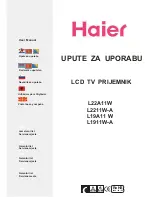
CC2500
SWRS040C
Page 17 of 89
6
Circuit Description
BIAS
PA
RBIAS
XOSC_Q1
XOSC_Q2
CSn
SI
SO (GDO1)
XOSC
SCLK
LNA
0
90
FREQ
SYNTH
ADC
ADC
D
E
M
O
D
U
L
A
T
O
R
F
E
C
/
IN
T
E
R
L
E
A
V
E
R
P
A
C
K
E
T
H
A
N
D
L
E
R
R
X
F
IF
O
M
O
D
U
L
A
T
O
R
T
X
F
IF
O
D
IG
IT
A
L
IN
T
E
R
F
A
C
E
T
O
M
C
U
RADIO CONTROL
RF_P
RF_N
GDO2
GDO0 (ATEST)
RC OSC
Figure 2:
CC2500
Simplified Block Diagram
A simplified block diagram of
CC2500
is shown
in Figure 2.
CC2500
features a low-IF receiver. The
received RF signal is amplified by the low-
noise amplifier (LNA) and down-converted in
quadrature (I and Q) to the intermediate
frequency (IF). At IF, the I/Q signals are
digitised by the ADCs. Automatic gain control
(AGC), fine channel filtering, demodulation
bit/packet
synchronization
are
performed
digitally.
The transmitter part of
CC2500
is based on
direct synthesis of the RF frequency.
The
frequency
synthesizer
includes
a
completely on-chip LC VCO and a 90 degrees
phase shifter for generating the I and Q LO
signals to the down-conversion mixers in
receive mode.
A crystal is to be connected to
XOSC_Q1
and
XOSC_Q2
. The crystal oscillator generates the
reference frequency for the synthesizer, as
well as clocks for the ADC and the digital part.
A 4-wire SPI serial interface is used for
configuration and data buffer access.
The digital baseband includes support for
channel configuration, packet handling, and
data buffering.
7
Application Circuit
Only a few external components are required
for using the
CC2500
. The recommended
application circuit is shown in Figure 3. The
external components are described in Table
14, and typical values are given in Table 15.
Bias Resistor
The bias resistor R171 is used to set an
accurate bias current.
Balun and RF Matching
The components between the
RF_N
/
RF_P
pins
and the point where the two signals are joined
together (C122, C132, L121, and L131) form a
Содержание CC2500
Страница 91: ...PACKAGE OPTION ADDENDUM www ti com 6 Feb 2020 Addendum Page 2 ...
Страница 94: ......
Страница 95: ......
















































